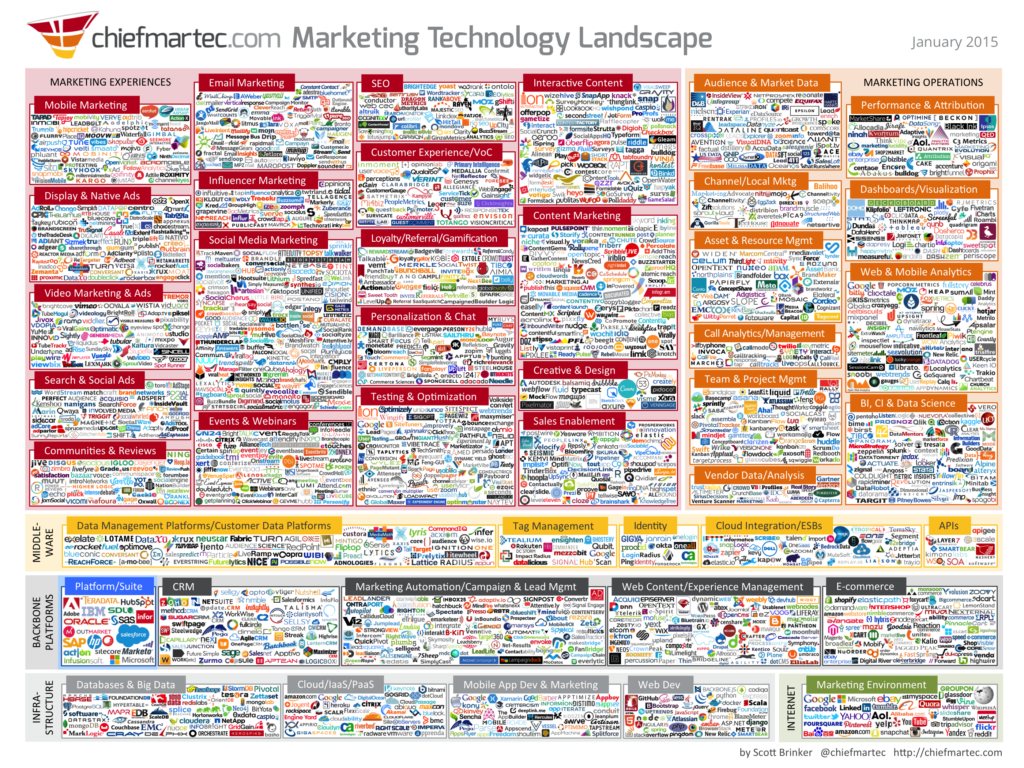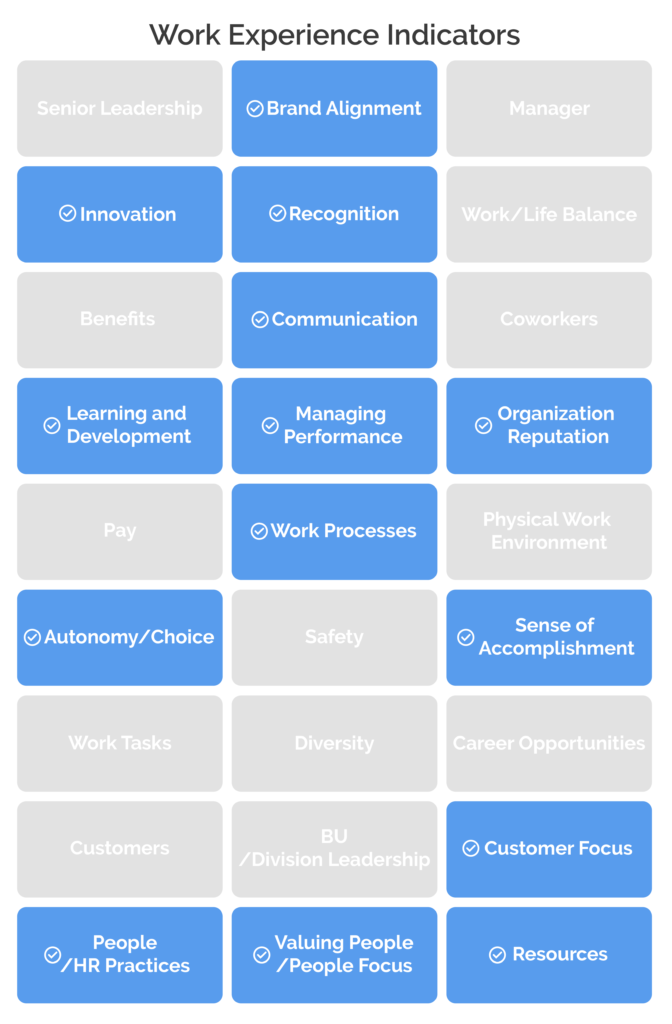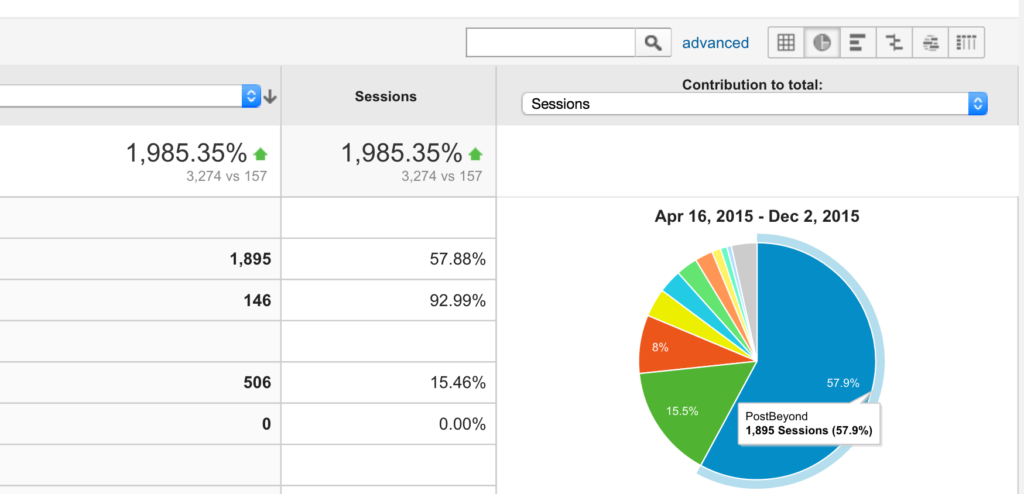It’s that time of year when managers and executives take the time to reflect on what was successful in the past year, what needs to improve, and what needs to stop at your enterprise.
We’re currently doing the same at PostBeyond, and getting very excited about next year! But this post isn’t about us.
We’re a strong believer in sharing knowledge. It makes all of us better at our jobs, and also helps deliver a better customer experience.
We spoke to thousands of enterprise managers this year, and here’s what we learned about that you should know for 2016:
1. Choosing Software Vendors That Integrate With Your Existing Stack
We’re all a bit overwhelmed when it comes to technology. For example, here’s an image of over 1,800 different marketing technologies in 2015 (this doesn’t even come close to everything that’s available – only vendors who are fairly established in their categories).

It’s getting tougher and tougher to select new software. Data gets collected in different locations, and reporting becomes scattered.
In 2016, managers will focus on a key set of legacy softwares (like Sharepoint, Salesforce, and Google Analytics), and find new tools that integrate seamlessly with the investment in these existing stacks.
There are certain staples in the enterprise that aren’t going anywhere. As a manager, evaluate vendors that either integrate or have connectors with your core toolset.
2. Using Content For Internal Communications
We’ve written a lot about using content to educate employees, and for good reason. Often when it comes to creating an employee advocacy program at your enterprise, the initial goal is to get employees to share more on social. But what we’ve learned from customers and prospects is that establishing a formal program helps employees acquire the right company and industry knowledge – sharing becomes a bonus.
By educating your workforce with content, you’re investing in their knowledge and making them more efficient at communicating, which results in them being better at their job.
On top of that, AON Hewitt found that improving internal communication leads to better employee engagement (another key trend in 2016). Our Community Manager discussed this in her latest blog post. We did a critical assessment of the various factors AON Hewitt discussed in their study, and applied them to a formal enterprise social media advocacy program. It turns out that a formal program addresses 14 of 27 critical points around employee engagement.

In 2016, think about how to improve internal communications at your enterprise, and what role content can play in it.
3. Omni-Channel Employee Experience
We hear a lot about omni-channel marketing (mobile, web, social, print, retail, e-commerce, etc.) And why is it so important? Because you want to reach customers when they’re most active, and on their turf.
This trend is creeping into the employee experience as well, as we can hear from managers. There are four different generations in the workplace right now. Some are more comfortable with dialing and emails, or intranets. But the digital mindset has also trickled in with Millennials.
With digital transformation at the forefront of the future of work, enterprises will need to adapt the employee experience in 2016.
Lines are blurring between business and personal. This means that you’ll need to pay attention to the following for your employees:
- Mobile first communications
- Secure access to files from anywhere
- Single sign-on into tools with your legacy systems
- Communications through email, push notification, apps, content, SMS, etc.
- Empower employees on social media.
As more digital natives enter the workforce, the less time you have to adapt. If you’re not considering this omni-channel employee experience in 2016, you’re already behind.
4. Social Media Attribution a Priority in Digital Marketing
Vanity metrics have become a tablestake in reporting at this point (i.e. likes, shares, clicks). Everyone understands them, and are trying to extract value from them.
But managers and executives are becoming more strategic about attribution to social media.
Technology has evolved to a point where it’s now easier to attribute social to lead generation or talent acquisition (especially in B2B, in my opinion). As long as you have the right tech stack at your enterprise, and you’re working on ways to integrate tools, then attribution is doable.
In most cases, it’s trying to determine where traffic is coming from, and how it behaves once you acquire it. For example, any links coming from the PostBeyond platform has UTM_Campaign parameters. So if every link you share has a campaign tag attached to it, you can segment your web analytics by that campaign and get a sense of behaviour.

UTM_Campaigns and Google Analytics are also supported in most marketing automation tools (we enabled ours in Pardot). So if a lead fills out a form on your website, you can attribute the lead back to your social media software. Leads then get passed through to your CRM (like Salesforce), and if someone becomes a customer over time, the data gets passed back to your marketing reporting, closing the loop on the attribution funnel.

From what we hear, many marketers at the enterprise level are starting to think more about social media reporting in this way, and caring a lot less about vanity metrics. This is a trend to watch in 2016.
5. Closing the Knowledge Gap
Advancements in digital have given us access to tons of data. For example, in 2015, the amount of data produced every two days matches the amount of data produced in all of history prior to 2003.
Almost everything is measurable. With this, there’s a lot of software that allows you to extract data. Everywhere you look, data, data, data.
But there’s one fundamental problem with this trend in the industry: Many marketers that are now in charge of social media reporting and attribution, and many don’t come from a numbers background.
If data is misread, it can be terribly misleading and more harmful than helpful. Adding more data sources to the mix is not the best answer.
We see the industry evolving to software recommending insights over raw data. Look out for better analytics tools in 2016, or tools that integrate with your existing tracking softwares.
6. Social Becoming The Starting Point
There’s been a lot of progress in social selling over the last couple years, and enterprises are looking to enable their sales and support teams on social media.
Social conversations are direct with employees, and not with “marketing.” Some companies have done a great job enabling a social-first approach to customer communications as the digital mindset evolves, and for good reason:
- Sales reps using social media as part of their sales techniques outsell 78 percent of their peers (Source: Forbes).
- 92 percent of buyers say they delete emails or voicemail messages when comes from someone that they do not know (Source: A Sales Guy Consulting).
- Content shared by employees receives eight times more engagement than content shared by brand channels (Source: Social Media Today).
- Brand messages reached 561 percent further when shared by employees vs the same messages shared via official brand social channels (Source: MSLGroup).
- 98 percent of employees use at least one social media site for personal use, of which 50 percent are already posting about their company (Source: Weber Shandwick).
- 67 percent of employers and recruiters said that the recruiting process was shorter and 51 percent said it was less expensive to recruit via referrals (Source: Jobvite).
- Employees of socially engaged companies are… (Source: Altimeter & LinkedIn Relationship Economics 2014)
- 57 percent more likely to align social media engagement to more sales leads.
- 20 percent more likely to stay at their company.
- 27 percent more likely to feel optimistic about their company’s future.
- 40 percent more likely to believe their company is more competitive.
Look out for more enterprises taking this approach in the new year.
7. Content Serving A Purpose
A big trend we’re starting to hear from enterprises (which was validated when we went to Social Tools Summit) is content having a bigger role in sales.
Enterprise managers are starting to think about how to use content strategically to educate employees and customers, and how it can solve a problem or challenge in the sales funnel. There’s more emphasis on tying the content strategy to the various parts of the customer journey. By doing this, content becomes part of a revenue engine, and isn’t just created for hype and SEO crawlers.
Look out for more thoughtful and targeted content from enterprises next year.
8. Investing In Personal Branding
Employees have several social profiles, and are increasingly conscious about what they share online. From the enterprise level, we’re hearing that managers want to help shape that personal brand through proper education and tools.
In 2016, more employees will actively be involved in corporate social media efforts, especially on LinkedIn and Twitter. Managers will invest in tools that help empower and enable employees to build their personal brands.
What It’s All About
It’s clear that there are two common themes happening at the enterprise:
- A renewed focus on employee communications (internal or external)
- Navigating the complexities of digital transformation
I’m sure many of these trends we’ve identified will evolve and get even more complicated next year.
My question to you: Where do you stack up against what we hear from the enterprises? Are you on-par with these trends for 2016? Or are you far behind?
Take the time to reflect. There might be significant changes and investments you need to make next year if you want to be around for 2017 trends…




